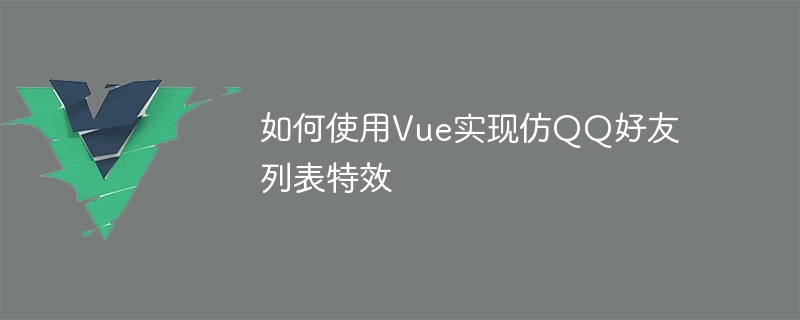

How to use Vue to implement imitation QQ friend list effects
With the popularity and application of the Vue framework in front-end development, more and more developers are beginning to use Vue to build a variety of powerful web applications. In this article, we will introduce how to use Vue to implement special effects that imitate the QQ friend list, and illustrate it through specific code examples.
Before you start writing code, you first need to make preparations. Please make sure you have Node.js and Vue CLI installed.
First, use the following command to create a new Vue project:
vue create friend-list-effect
Then, enter the root directory of the project:
cd friend-list-effect
Next, install the required plug-ins and dependencies:
npm install axios vuex vue-router
Create components and views folders in the src directory to store components and view-related files respectively.
Create FriendList.vue under the components folder, the code is as follows:
<template>
<div>
<ul>
<li v-for="friend in friends" :key="friend.id" @click="toggleActive(friend.id)" :class="{ active: friend.active }">
{{ friend.name }}
</li>
</ul>
</div>
</template>
<script>
export default {
name: 'FriendList',
data() {
return {
friends: [
{ id: 1, name: 'Friend 1', active: false },
{ id: 2, name: 'Friend 2', active: false },
{ id: 3, name: 'Friend 3', active: false },
// 更多好友...
],
};
},
methods: {
toggleActive(id) {
this.friends = this.friends.map((friend) => {
if (friend.id === id) {
return { ...friend, active: !friend.active };
}
return friend;
});
},
},
};
</script>Create Home.vue under the views folder, the code is as follows:
<template>
<div>
<h1>仿QQ好友列表特效</h1>
<FriendList />
</div>
</template>
<script>
import FriendList from '../components/FriendList.vue';
export default {
name: 'Home',
components: {
FriendList,
},
};
</script>In the router folder Create index.js under, the code is as follows:
import Vue from 'vue';
import VueRouter from 'vue-router';
import Home from '../views/Home';
Vue.use(VueRouter);
const routes = [
{
path: '/',
name: 'Home',
component: Home,
},
];
const router = new VueRouter({
mode: 'history',
base: process.env.BASE_URL,
routes,
});
export default router;Find the main.js file in the src directory, add the following code:
import Vue from 'vue';
import App from './App.vue';
import router from './router';
Vue.config.productionTip = false;
new Vue({
router,
render: (h) => h(App),
}).$mount('#app');In src Find the App.vue file in the directory and replace the template code with the following content:
<template>
<div id="app">
<router-view />
</div>
</template>Use the following command to start the Vue application:
npm run serve
Browse Open http://localhost:8080/ in the browser, and you can see the application that imitates the special effects of QQ friend list.
Through the above steps, we successfully used Vue to build an application that imitates the special effects of QQ friend list. In this application, the friend list displays a group of friends, and the status of the friends can be switched.
The core of the application is the FriendList component, which renders the friend list through a loop and implements friend status switching through event binding and data binding. This is a simple example, you can further extend and modify the code according to your needs.
I hope this article will help you understand how to use Vue to implement QQ-like friend list effects. Wish you write more powerful Vue applications!
The above is the detailed content of How to use Vue to implement QQ-like friend list effects. For more information, please follow other related articles on the PHP Chinese website!